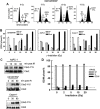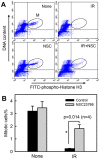Inhibition of RAC1 GTPase sensitizes pancreatic cancer cells to γ-irradiation
- PMID: 25344910
- PMCID: PMC4279370
- DOI: 10.18632/oncotarget.2500
Inhibition of RAC1 GTPase sensitizes pancreatic cancer cells to γ-irradiation
Erratum in
-
Correction: Inhibition of RAC1 GTPase sensitizes pancreatic cancer cells to γ-irradiation.Oncotarget. 2020 Jan 21;11(3):304. doi: 10.18632/oncotarget.27450. eCollection 2020 Jan 21. Oncotarget. 2020. PMID: 32076492 Free PMC article.
Abstract
Radiation therapy is a staple treatment for pancreatic cancer. However, owing to the intrinsic radioresistance of pancreatic cancer cells, radiation therapy often fails to increase survival of pancreatic cancer patients. Radiation impedes cancer cells by inducing DNA damage, which can activate cell cycle checkpoints. Normal cells possess both a G1 and G2 checkpoint. However, cancer cells are often defective in G1 checkpoint due to mutations/alterations in key regulators of this checkpoint. Accordingly, our results show that normal pancreatic ductal cells respond to ionizing radiation (IR) with activation of both checkpoints whereas pancreatic cancer cells respond to IR with G2/M arrest only. Overexpression/hyperactivation of Rac1 GTPase is detected in the majority of pancreatic cancers. Rac1 plays important roles in survival and Ras-mediated transformation. Here, we show that Rac1 also plays a critical role in the response of pancreatic cancer cells to IR. Inhibition of Rac1 using specific inhibitor and dominant negative Rac1 mutant not only abrogates IR-induced G2 checkpoint activation, but also increases radiosensitivity of pancreatic cancer cells through induction of apoptosis. These results implicate Rac1 signaling in the survival of pancreatic cancer cells following IR, raising the possibility that this pathway contributes to the intrinsic radioresistance of pancreatic cancer.
Figures











Similar articles
-
RAC1 GTPase plays an important role in γ-irradiation induced G2/M checkpoint activation.Breast Cancer Res. 2012 Apr 11;14(2):R60. doi: 10.1186/bcr3164. Breast Cancer Res. 2012. PMID: 22494620 Free PMC article.
-
A novel function of HER2/Neu in the activation of G2/M checkpoint in response to γ-irradiation.Oncogene. 2015 Apr 23;34(17):2215-26. doi: 10.1038/onc.2014.167. Epub 2014 Jun 9. Oncogene. 2015. PMID: 24909175 Free PMC article.
-
RAC1 GTPase promotes the survival of breast cancer cells in response to hyper-fractionated radiation treatment.Oncogene. 2016 Dec 8;35(49):6319-6329. doi: 10.1038/onc.2016.163. Epub 2016 May 16. Oncogene. 2016. PMID: 27181206 Free PMC article.
-
[Cell cycle regulation after exposure to ionizing radiation].Bull Cancer. 1999 Apr;86(4):345-57. Bull Cancer. 1999. PMID: 10341340 Review. French.
-
Rac1 as a therapeutic anticancer target: Promises and limitations.Biochem Pharmacol. 2022 Sep;203:115180. doi: 10.1016/j.bcp.2022.115180. Epub 2022 Jul 16. Biochem Pharmacol. 2022. PMID: 35853497 Review.
Cited by
-
Rac1, A Potential Target for Tumor Therapy.Front Oncol. 2021 May 17;11:674426. doi: 10.3389/fonc.2021.674426. eCollection 2021. Front Oncol. 2021. PMID: 34079763 Free PMC article. Review.
-
Rac1 overexpression is correlated with epithelial mesenchymal transition and predicts poor prognosis in non-small cell lung cancer.J Cancer. 2016 Oct 23;7(14):2100-2109. doi: 10.7150/jca.16198. eCollection 2016. J Cancer. 2016. PMID: 27877226 Free PMC article.
-
Rac1 is a potential target to circumvent radioresistance.J Thorac Dis. 2016 Nov;8(11):E1475-E1477. doi: 10.21037/jtd.2016.11.79. J Thorac Dis. 2016. PMID: 28066635 Free PMC article. No abstract available.
-
RAC1 Involves in the Radioresistance by Mediating Epithelial-Mesenchymal Transition in Lung Cancer.Front Oncol. 2020 Apr 28;10:649. doi: 10.3389/fonc.2020.00649. eCollection 2020. Front Oncol. 2020. PMID: 32411607 Free PMC article.
-
The role of Rac in tumor susceptibility and disease progression: from biochemistry to the clinic.Biochem Soc Trans. 2018 Aug 20;46(4):1003-1012. doi: 10.1042/BST20170519. Epub 2018 Jul 31. Biochem Soc Trans. 2018. PMID: 30065108 Free PMC article. Review.
References
-
- Callery MP, Chang KJ, Fishman EK, Talamonti MS, William Traverso L, Linehan DC. Pretreatment assessment of resectable and borderline resectable pancreatic cancer: expert consensus statement. Ann Surg Oncol. 2009;16:1727–1733. - PubMed
-
- Aref A, Berri R. Role of Radiation Therapy in the Management of Locally Advanced Pancreatic Cancer. Journal of Clinical Oncology. 2012;30:1564–1565. - PubMed
-
- Blackstock AW, Bernard SA, Richards F, Eagle KS, Case LD, Poole ME, Savage PD, Tepper JE. Phase I trial of twice-weekly gemcitabine and concurrent radiation in patients with advanced pancreatic cancer. J Clin Oncol. 1999;17:2208–2212. - PubMed
-
- Brade A, Brierley J, Oza A, Gallinger S, Cummings B, Maclean M, Pond GR, Hedley D, Wong S, Townsley C, Brezden-Masley C, Moore M. Concurrent gemcitabine and radiotherapy with and without neoadjuvant gemcitabine for locally advanced unresectable or resected pancreatic cancer: a phase I-II study. Int J Radiat Oncol Biol Phys. 2007;67:1027–1036. - PubMed
Publication types
MeSH terms
Substances
Grants and funding
LinkOut - more resources
Full Text Sources
Other Literature Sources
Medical
Research Materials
Miscellaneous

